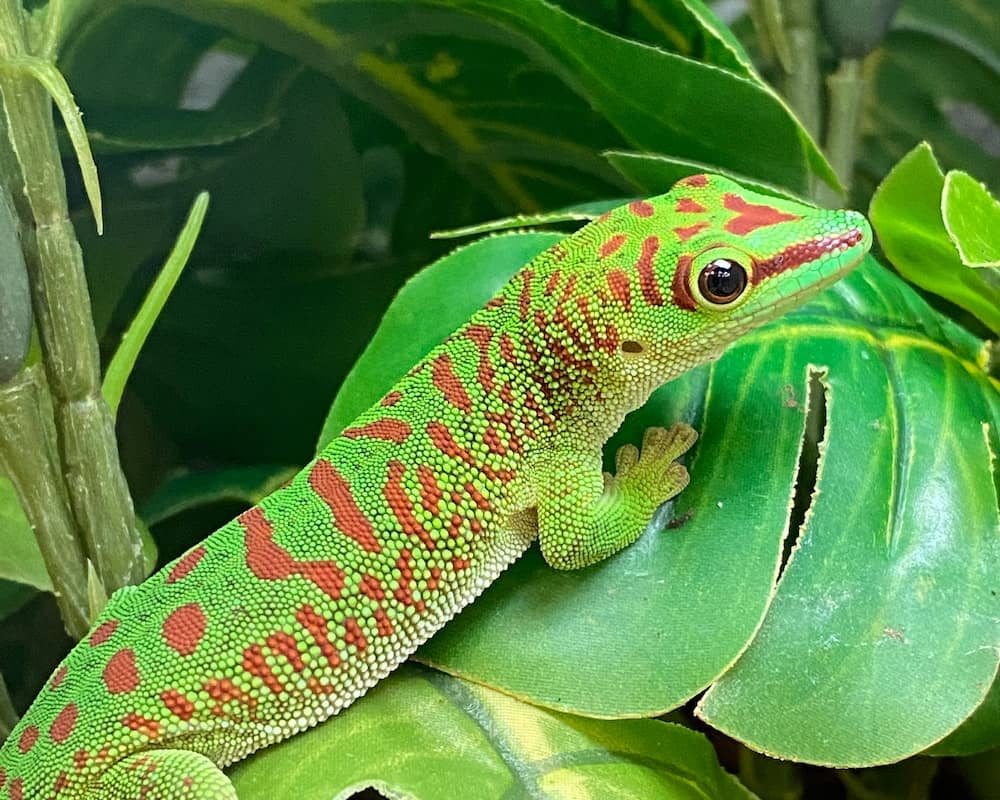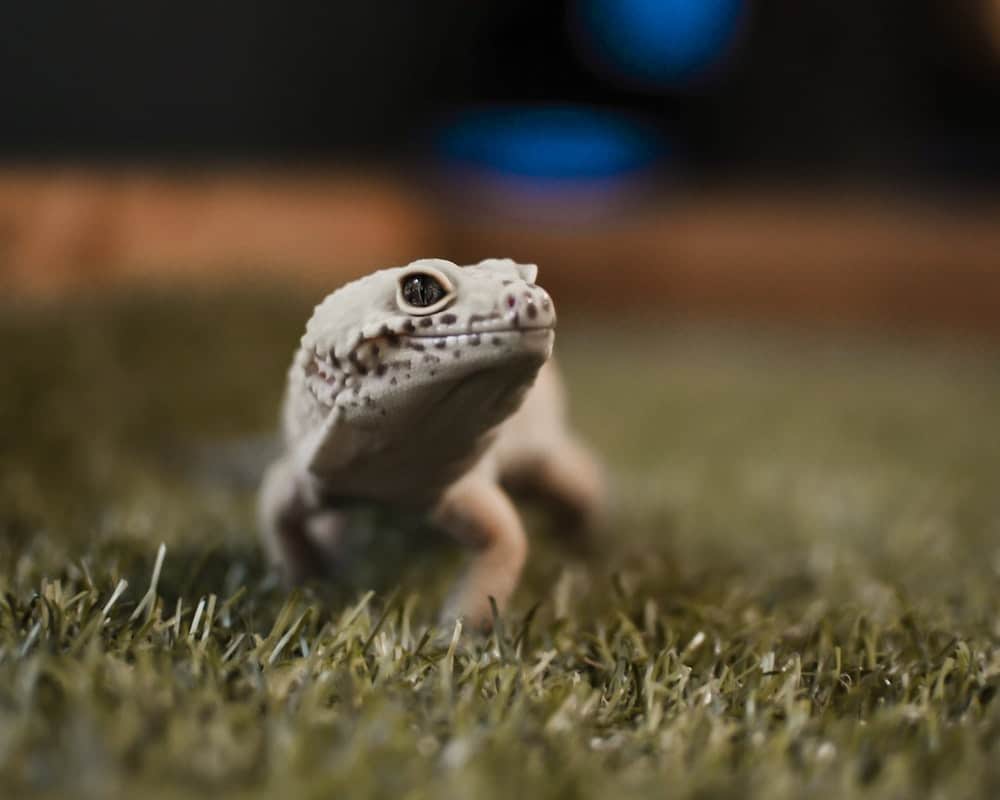Yes, a gecko can change its color. It does so to hide from predators, signal something specific, or regulate body temperature. Several stimuli, like temperature and light, lead to a color change in geckos. Not all geckos have this ability. There are only some, like crested geckos, that can change color.
Why Do Geckos Change Color?
Below are some of the critical reasons why geckos change color.
- Camouflage
The top reason these geckos change their color is to blend in or mix in with the surface they are resting or sitting at.
By changing the color and pattern of their skin, these geckos can save themselves from the eyes of many predators. They can take the color of the surface they are sitting at and bluff the predators while hunting for these geckos.
Their ability to change color gives them confidence and makes them feel safe to go out there and enjoy the wild.
- Thermoregulation
Geckos are, in general ectothermic. Being ectothermic means the temperature at which their body stays depends upon the temperature outside. They derive their body temperature from the environment outside.
For example, if the gecko has turned dark in color, then it will be able to absorb or take in more heat and vice versa. By changing from light to dark in their skin color, they can decide their body temperature and the amount of heat they observe from the sun or give back to the environment.
- Communication
Your gecko might change color to communicate something, as it can’t speak. They use this as a medium to communicate with other geckos.
For example, you may notice that the male gecko has changed its color during the mating season. This signals that they’re ready to mate with the female ones.
It might be a signal or an assertion of dominance over all the other males residing in the territory. In some species, the color change during the courtship display signals that a gecko is sexually ready for potential mates.
- Social Signaling
Social signaling is also a type of communication only that these geckos use. When we say social signaling, it means the reason that the color change occurs, along with the mating behavior, is to share any important information with other nearby geckos.
For example, some of these geckos could change their skin color to signal potential predators or any dangers they could encounter. For this, if a gecko feels unsafe in the environment, it may change its color in fear or stress and signal the other gecko’s about the potential threat.
- Physiological State
Color change in some geckos’ skin may result from changes in the physiological state like health, mood, etc.
For example, many geckos change their skin color to darker when they are frightened and stressed, while many others become lighter when they are relaxed and sleeping.
How Do Geckos Change Color?
Chromatophores are the cells through which your gecko changes its colors. You must be wondering what chromatophores are.
Chromatophores are cells that have specialized pigments. These specialized pigments are responsible for the color change of the gecko’s skin.
These chromatophores are mainly sitting in the outer layer of the geckos’ skin, also known as the epidermis. The chromatophores are controlled by the nervous system of the geckos.
Types of Chromatophores:
There are many types of chromatophores present in these geckos’ skin. Each of these chromatophores has a different pigment.
For example, erythrophores contain a red pigment; melanophores have brown or black pigments, etc.
There is still some research going on to find out the exact mechanism that works in these geckos’ skin, which helps to control these chromatophores, but it has been concluded that the color change in these geckos’ skin is a result of both neural and hormonal signals.
For example, when a gecko is exposed to a change in light or temperature, a signal will be sent to the brain, and the brain, in turn, sends signals to chromatophores to change the skin color accordingly.
Check out this video of a gecko changing color!
Factors That Influence The Color Change In Geckos
- Temperature
Temperature fluences the color change in these geckos the most.
When the temperature is very low, the chromatophores contract, making the gecko’s skin appear very light in color. At high temperatures, the chromatophores expand and make the gecko’s skin appear very dark.
- Light
Another environmental factor that has influenced the coloration of the skin of the geckos is the change in light.
Photoreceptors in the skin of these geckos are responsible for their response to changes in the light levels. The geckos’ skin appears light or dark depending on the amount of light it is receiving or present in the environment.
Some of these geckos change their color to camouflage or completely mix and become invisible in the surroundings.
- Hormones
The release of any hormones in the body of the geckos also sends signals to its brain for the coloration of the skin. For example, when the breeding season is going on, there will be more testosterone produced by mail geckos which, as a result, changes the skin color of these geckos.
- Physiological State
The physiological state means the stressors or stimuli present in the environment that causes the change in color of the skin of these geckos. For example, it changes color when frightened and stressed, and its skin becomes darker and vice versa.
They can also change color if they have any illness, for example, necrosis. In this type of situation, their toes and tail will turn black.
- Age
They may also change color as they grow older. Until a gecko is 12 months older, i.e., it has entered adulthood, it may show the actual color of its skin. However, the color starts fading off as soon as it gets older.
Various Species of Geckos That Show Color-Changing Behavior
- Chameleon Gecko
These types of geckos are mainly found in Madagascar. The color change can vary from light green to dark, black or brown, depending on the abovementioned factors.
By changing their color, these geckos avoid getting hunted and become invisible in the environment.
- Tokay Gecko
This type of gecko is mainly found in Southeast Asia. When these geckos are calm and resting, they have very different blue-grayish colored skin. They turn bright red whenever they feel threatened or fearful in their environment.
Red is a warning signal, so this color change acts as a warning signal to potential predators that the gecko is poisonous.
- Leopard Gecko
This gecko is usually found in countries like Afghanistan, Pakistan, and other desert areas like some parts of India, etc. These types of geckos can change their color slightly from yellow to brown due to changes in their environment or physiological state.
- Crested Gecko
Crested geckos are very vulnerable and fragile pets. These types of geckos want to change their color due to physiological stressors or hide from predators due to temperature, maybe as a warning or fearful signal.
Conclusion
In conclusion, you should not be scared if you see a gecko changing its color or becoming invisible in the environment. They have the unique ability to change their color whenever they feel frightened, stressed, etc.
These geckos change color through a proper procedure performed by chromatophores sitting on their skin. Not all geckos are blessed with this ability to change their color, but some, like leopard geckos, crested geckos, etc, mentioned in the article above, have this feature.
FAQs
- What Does It Mean When My Crested Gecko Gets Darker?
Getting darker is also known as getting fired up. Crested geckos usually change color to express emotions like happiness, anger, fear, disappointment, etc. So, your crested gecko must have become darker in color to express one of these emotions. You should check its captivity immediately and see if anything you notice can be bothersome for your gecko.
- Do Crested Geckos Change Color As They Get Older?
Yes, your crested gecko will be of different colors when you get them, ie, when they were juveniles, and they will have different colors when they grow older.


